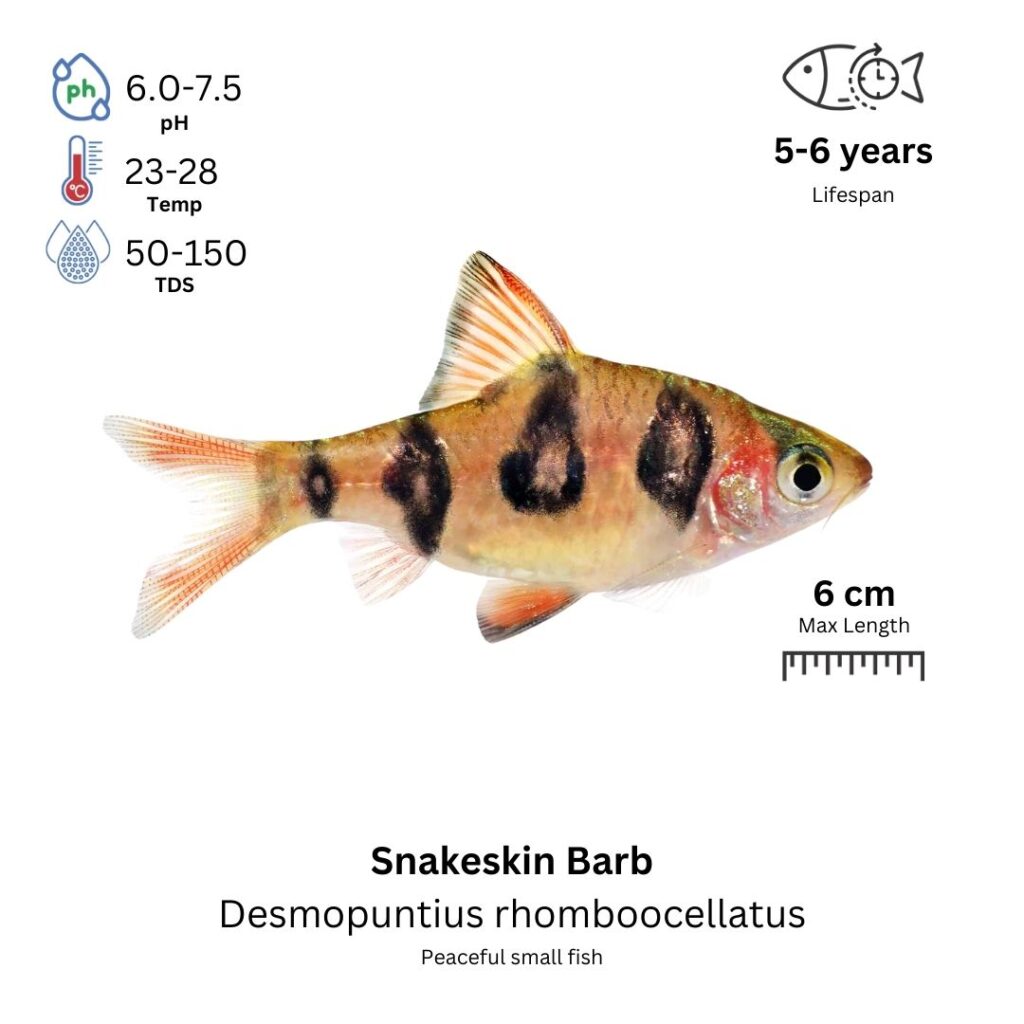Snakeskin Barb
Barbus callipterus

Description
The Snakeskin Barb is a strikingly beautiful species known for its unique coloration and distinctive pattern, which resembles that of snake scales. The body is elongated and covered in dark, irregular markings that create a pattern resembling snakeskin. These markings are often lighter or gold in color, standing out against the darker background of the body. The body of the Snakeskin Barb is generally a pale, silvery to golden color, with the darker markings accentuating its overall appearance. The fins are typically translucent, with a hint of red or orange along the edges, particularly in males during breeding seasons.
Habitat Origin
Native to the slow-moving rivers, streams, and lakes of Southeast Asia, particularly in countries like Thailand, Malaysia, and Cambodia. These fish are typically found in clear, slightly acidic to neutral waters with a moderate flow, often in regions with dense vegetation and submerged structures like rocks and roots. They prefer environments with well-oxygenated water and an abundance of plant life.
Aquarium
Ideal Number in Aquarium: At least 6 individuals, as they are schooling fish and feel more secure in groups.
Favorite Food

Snakeskin Barbs are omnivores and will accept a variety of foods. They can be fed high-quality flake food, micro pellets, and live or frozen foods like brine shrimp, bloodworms, and daphnia. They will also graze on small algae and plant matter, so incorporating vegetable-based foods like spirulina or blanched zucchini into their diet is beneficial. A varied diet is important for maintaining their vibrant coloration and overall health.
Behavior:
Snakeskin Barbs are active, peaceful, and social fish that do best when kept in groups. They exhibit natural schooling behavior, swimming together in tight formations. These fish are generally non-aggressive but can become territorial during breeding periods, especially males competing for females. They are active swimmers and will often be seen exploring the middle and upper regions of the tank. Snakeskin Barbs do well in community aquariums with other peaceful species but should not be housed with overly aggressive fish or those that may outcompete them for food.
Special Care:
Snakeskin Barbs require stable water conditions, including regular water changes and good filtration, to thrive. A well-planted tank with plenty of open swimming space is ideal, as they enjoy swimming in schools and exploring their environment. Providing hiding spots like rocks and driftwood is important, as these fish are not overly aggressive but still appreciate having areas to retreat to. Monitoring water temperature and pH is essential to keep them in their preferred conditions. These fish are hardy but do best in an environment that mimics their natural habitat, with soft to medium water hardness and moderate flow.
Compatibility with Other Fish:
Snakeskin Barbs are compatible with a wide variety of peaceful species. They can be housed with other small, non-aggressive fish like tetras, rasboras, peaceful cichlids, and small catfish. They can also coexist with snails and shrimp. However, they should not be kept with larger or overly aggressive species, as these may bully or intimidate the barbs. A peaceful community tank with other similarly sized species is ideal for Snakeskin Barbs.
Breeding Tank Setup
A separate breeding tank is essential when breeding Snakeskin Barbs to prevent interference from other fish and to maintain precise environmental control. A 60–80 liter (15–20 gallon) tank is sufficient for a breeding group, providing ample swimming space and reducing stress. Maintain pH between 6.5–7.5, temperature between 24–28°C (75–82°F), and water hardness around 5–12 dGH. Use a gentle sponge filter to ensure clean, oxygen-rich water without strong currents. For substrate, choose fine gravel or sand, and include fine-leaved plants such as Java moss or Anubias for egg-laying. Soft lighting on a 10–12 hour cycle is sufficient, with some shaded areas to mimic their natural habitat.
Conditioning the Breeders
To prepare Snakeskin Barbs for breeding, feed them a high-protein and varied diet. Live or frozen foods such as brine shrimp, daphnia, and bloodworms are excellent conditioning options, supported by high-quality flakes or pellets. Conditioning should last about 7 days. Before spawning, perform a 20–30% water change using slightly cooler, aged water to mimic seasonal rainfall. This often triggers natural spawning instincts, especially when paired with stable tank conditions and nutritious feeding.
Spawning Process
Spawning typically occurs early in the morning, particularly after a water change. Males display vibrant red or orange colors and chase females around the tank. A healthy female can lay 100–300 eggs, which are scattered over plants or smooth surfaces like stones. Once eggs are laid, remove the adults immediately, as Snakeskin Barbs have a tendency to eat their own eggs. The adhesive eggs will remain safely attached to the plants or substrate and begin developing in the following days.
Fry Hatching & Care
Eggs hatch in about 2–4 days, depending on water temperature. After hatching, fry remain motionless for a couple of days while absorbing their yolk sacs. Once free-swimming, feed them infusoria or liquid fry food for the first few days. As they grow, introduce newly hatched brine shrimp or crushed flakes after about a week. Keep water quality pristine with 10–15% water changes every 2–3 days, maintain stable temperatures, and avoid strong water movement. Use a sponge filter to prevent fry from being sucked in and to preserve water clarity.
Additional Tips & Observations
Snakeskin Barbs become sexually mature at 1–2 years of age. Males are more colorful, with intense hues and smaller, slimmer bodies, while females are larger and rounder, particularly when gravid. To avoid stress, prevent overcrowding, sudden water changes, and eliminate any aggressive tankmates. Maintaining a peaceful environment, high-quality food, and stable water conditions will greatly improve breeding success and fry survival.
